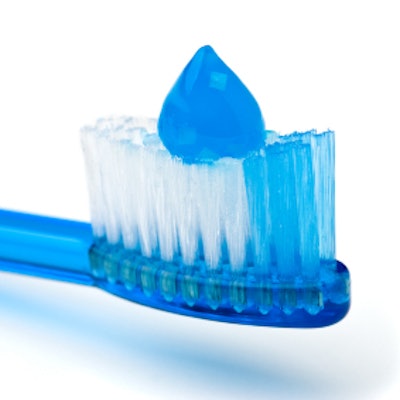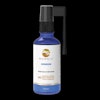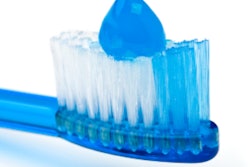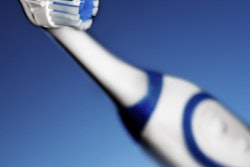
What should you tell your patients when they ask if whitening toothpastes are effective? Are claims that they remove tooth stains or whiten teeth substantiated? To find out if toothpastes live up to the marketing hype, researchers reviewed the existing literature comparing the effects of whitening and regular toothpastes.
They conducted a meta-analysis of studies that compared the effect on natural extrinsic tooth discoloration of brushing with whitening or regular dentifrices. The results suggest that the vast majority of whitening dentifrices improve tooth color.
"When compared to using a regular dentifrice, brushing with a whitening dentifrice does result in a significant reduction of tooth surface discoloration," the authors wrote (International Journal of Dental Hygiene, June 2, 2017).
The lead author of the study was G.D. Soeteman of the School for Dental Hygiene at the University of Applied Sciences Utrecht in the Netherlands.
Work as advertised
While there is good evidence to recommend toothbrushing twice a day with toothpaste containing fluoride, a wide array of dentifrices now sold contain ingredients that are said to help remove and prevent extrinsic staining of teeth or to whiten teeth, according to the study authors.
“When compared to using a regular dentifrice, brushing with a whitening dentifrice does result in a significant reduction of tooth surface discoloration.”
Extrinsic tooth surface discoloration or staining is caused by retained colored substances in bacterial plaque and the acquired pellicle, and it can be influenced by chromogenic plaque bacteria, smoking habits, and ingestion of chromogens, such as red wine, coffee, or tea, they noted. Other factors that can contribute to staining include inadequate toothbrushing, which can allow stained pellicles and colored deposits to accumulate, and using low-abrasive dentifrices, they added.
It is widely accepted that dentifrices that remove or prevent extrinsic stains must have some abrasivity, according to the authors. Dentifrices designed to remove these stains typically contain greater amounts of abrasive ingredients and detergents than standard dentifrices, and whitening dentifrices may also include chemical discoloration agents to aid in stain removal.
Studies that support claims that these products remove stains from teeth or whiten them have not been previously systematically reviewed, so the current study authors conducted a systematic review and meta-analysis. They searched medical research databases for randomized controlled or controlled clinical trials conducted in human adults that compared tooth color or staining after brushing with either a whitening or a regular dentifrice.
The researchers also had the following requirements for the included studies:
- Participants were not institutionalized and were in good general health with no system disorders.
- Participants did not have periodontal pockets greater than 5 mm or large restorations in the included teeth.
- Participants had naturally occurring staining (versus induced staining, such as those involving tea or chlorhexidine).
- Follow-up periods were at least six weeks long.
- Studies used a measurement scale that scored extrinsic staining.
They identified 21 journal articles that included 32 comparisons that met their requirements, although there was considerable heterogeneity among them. Each study included between 27 and 98 participants in each dentifrice group.
The follow-up period was six weeks in 16 studies and eight weeks in two studies, and three other studies had follow-up periods of 12 weeks, three months, and six months. Subjects in all but one study regularly visited a dentist.
All the studies randomly allocated dentifrices to the participants. Overall, they compared 16 different whitening dentifrices with five regular dentifrices. Three compared the same dentifrices: Colgate Plus Whitening with Colgate Total (Colgate-Palmolive).
Participants were given a variety of instructions, with some told to brush for one minute, some for two, and others were not given any information on brushing duration. Some were told to use a soft manual toothbrush, others to use their regular toothbrush, and some were given no information about the type of toothbrush. Only one study gave information about the amount of dentifrice to be used, instructing that it be applied across the full length of the toothbrush head.
Seventeen studies gave instructions for participants not to use other oral hygiene products, although in one study they were permitted to do so, and in three they were given no instructions in this area.
Most of the studies were industry-funded. The authors determined that 20 studies had a moderate risk of bias and one had a substantial risk.
The researchers performed a meta-analysis for baseline and end scores for staining area, intensity, and composite score. They found no differences at baseline, but all end-scores showed a significant difference in favor of whitening dentifrice.
The stain area at the end of the studies measured with the original Lobene Stain Index and the modified version of the index found a significant reduction in the difference of means with whitening dentifrice compared with regular dentifrice (-0.44 and -0.41, respectively, on a scale of 0 to 3). For stain intensity, the difference of mean scores was also significantly better with whitening dentifrice (-0.35), as was composite score (-0.39).
When considering descriptive analysis, 22 of 23 comparisons showed a significant difference for extrinsic tooth surface discoloration staining area in favor of a whitening dentifrice, 18 of 22 for staining intensity, and 11 of 12 for a composite score combining both.
Subgroup analysis found that using whitening dentifrice with and without adjunctive chemical antidiscoloration agents significantly improved staining area, staining intensity, and composite scores, compared with using regular dentifrice.
| Comparisons between whitening dentifrice and regular dentrice | |||
| All whitening dentifrices | Whitening dentifrice with adjunctive chemical agents | Whitening dentifrice without adjunctive chemical agents | |
| Area | 22/23 (96%) | 16/17 (94%) | 6/6 (100%) |
| Intensity | 18/22 (82%) | 12/16 (75%) | 6/6 (100%) |
| Composite score | 11/12 (92%) | 7/8 (88%) | 4/4 (100%) |
Overall, the authors found the effect of using a whitening dentifrice to be moderate. Based on the quality and body of evidence, they concluded that whitening dentifrice is better than regular dentifrice for removing tooth surface discoloration.
"In this review, nearly all dentifrices that are specifically formulated for tooth whitening were shown to have a beneficial effect in reducing extrinsic tooth discoloration, irrespective of whether or not a chemical discoloration agent was added," they wrote.
Whiter but not perfect
The authors acknowledged some limitations of their study. They did not examine abrasive ingredients of the studied products. Additionally, the included studies evaluated adverse effects, but none included reports of any such effects. Enamel and dentine can be harmed by excessive abrasiveness, but the studies did not evaluate abrasion of hard dental tissues.
Manufacturers have calibrated the abrasivity levels in their products to balance the need for whitening and avoid negative effects on dental hard tissues, but this should be studied further in vivo, the authors noted. In addition, powered toothbrushes may reduce extrinsic tooth staining, and their combination with whitening dentifrice should be further studied as well, they wrote.
For patients with naturally occurring tooth surface discoloration, however, a whitening dentifrice can be recommended, the authors concluded.
"This advice is supported by the scientific evidence," they wrote. "Using a whitening dentifrice may reduce the need for professional dental prophylaxis for aesthetic reasons."



















